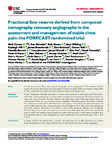Fractional flow reserve derived from computed tomography coronary angiography in the assessment and management of stable chest pain: the FORECAST randomized trial
| dc.contributor.author | Curzen, N | |
| dc.contributor.author | Nicholas, Z | |
| dc.contributor.author | Stuart, B | |
| dc.contributor.author | Wilding, S | |
| dc.contributor.author | Hill, K | |
| dc.contributor.author | Shambrook, J | |
| dc.contributor.author | Eminton, Z | |
| dc.contributor.author | Ball, D | |
| dc.contributor.author | Barrett, C | |
| dc.contributor.author | Johnson, L | |
| dc.contributor.author | Nuttall, J | |
| dc.contributor.author | Fox, K | |
| dc.contributor.author | Connolly, D | |
| dc.contributor.author | O’Kane, P | |
| dc.contributor.author | Hobson, A | |
| dc.contributor.author | Chauhan, A | |
| dc.contributor.author | Uren, N | |
| dc.contributor.author | Mccann, G | |
| dc.contributor.author | Berry, C | |
| dc.contributor.author | Carter, J | |
| dc.contributor.author | Roobottom, C | |
| dc.contributor.author | Mamas, M | |
| dc.contributor.author | Rajani, R | |
| dc.contributor.author | Ford, I | |
| dc.contributor.author | Douglas, P | |
| dc.contributor.author | Hlatky, M | |
| dc.date.accessioned | 2022-02-15T13:18:54Z | |
| dc.date.issued | 2021-10-01 | |
| dc.identifier.issn | 0195-668X | |
| dc.identifier.issn | 1522-9645 | |
| dc.identifier.uri | http://hdl.handle.net/10026.1/18787 | |
| dc.description.abstract |
<jats:title>Abstract</jats:title> <jats:sec> <jats:title>Aims </jats:title> <jats:p>Fractional flow reserve (FFRCT) using computed tomography coronary angiography (CTCA) determines both the presence of coronary artery disease and vessel-specific ischaemia. We tested whether an evaluation strategy based on FFRCT would improve economic and clinical outcomes compared with standard care.</jats:p> </jats:sec> <jats:sec> <jats:title>Methods and results </jats:title> <jats:p>Overall, 1400 patients with stable chest pain in 11 centres were randomized to initial testing with CTCA with selective FFRCT (experimental group) or standard clinical care pathways (standard group). The primary endpoint was total cardiac costs at 9 months. Secondary endpoints were angina status, quality of life, major adverse cardiac and cerebrovascular events, and use of invasive coronary angiography. Randomized groups were similar at baseline. Most patients had an initial CTCA: 439 (63%) in the standard group vs. 674 (96%) in the experimental group, 254 of whom (38%) underwent FFRCT. Mean total cardiac costs were higher by £114 (+8%) in the experimental group, with a 95% confidence interval from −£112 (−8%) to +£337 (+23%), though the difference was not significant (P = 0.10). Major adverse cardiac and cerebrovascular events did not differ significantly (10.2% in the experimental group vs. 10.6% in the standard group) and angina and quality of life improved to a similar degree over follow-up in both randomized groups. Invasive angiography was reduced significantly in the experimental group (19% vs. 25%, P = 0.01).</jats:p> </jats:sec> <jats:sec> <jats:title>Conclusion </jats:title> <jats:p>A strategy of CTCA with selective FFRCT in patients with stable angina did not differ significantly from standard clinical care pathways in cost or clinical outcomes, but did reduce the use of invasive coronary angiography.</jats:p> </jats:sec> | |
| dc.format.extent | 3844-3852 | |
| dc.format.medium | ||
| dc.language | en | |
| dc.language.iso | en | |
| dc.publisher | European Society of Cardiology | |
| dc.subject | Computed tomography coronary angiography | |
| dc.subject | Cost analysis | |
| dc.subject | Fractional flow reserve (FFRCT) | |
| dc.subject | Myocardial | |
| dc.subject | Randomized controlled trial | |
| dc.subject | Stable angina | |
| dc.subject | Quality of life | |
| dc.title | Fractional flow reserve derived from computed tomography coronary angiography in the assessment and management of stable chest pain: the FORECAST randomized trial | |
| dc.type | journal-article | |
| dc.type | Journal Article | |
| dc.type | Randomized Controlled Trial | |
| dc.type | Research Support, Non-U.S. Gov't | |
| plymouth.author-url | https://www.webofscience.com/api/gateway?GWVersion=2&SrcApp=PARTNER_APP&SrcAuth=LinksAMR&KeyUT=WOS:000709472700010&DestLinkType=FullRecord&DestApp=ALL_WOS&UsrCustomerID=11bb513d99f797142bcfeffcc58ea008 | |
| plymouth.issue | 37 | |
| plymouth.volume | 42 | |
| plymouth.publication-status | Published | |
| plymouth.journal | European Heart Journal | |
| dc.identifier.doi | 10.1093/eurheartj/ehab444 | |
| plymouth.organisational-group | /Plymouth | |
| plymouth.organisational-group | /Plymouth/Faculty of Health | |
| plymouth.organisational-group | /Plymouth/Faculty of Health/Peninsula Medical School | |
| plymouth.organisational-group | /Plymouth/REF 2021 Researchers by UoA | |
| plymouth.organisational-group | /Plymouth/REF 2021 Researchers by UoA/UoA01 Clinical Medicine | |
| plymouth.organisational-group | /Plymouth/REF 2021 Researchers by UoA/UoA01 Clinical Medicine/UoA01 Clinical Medicine | |
| plymouth.organisational-group | /Plymouth/Users by role | |
| plymouth.organisational-group | /Plymouth/Users by role/Academics | |
| dc.publisher.place | England | |
| dcterms.dateAccepted | 2021-06-25 | |
| dc.rights.embargodate | 2022-2-16 | |
| dc.identifier.eissn | 1522-9645 | |
| dc.rights.embargoperiod | Not known | |
| rioxxterms.versionofrecord | 10.1093/eurheartj/ehab444 | |
| rioxxterms.licenseref.uri | http://www.rioxx.net/licenses/all-rights-reserved | |
| rioxxterms.licenseref.startdate | 2021-10-01 | |
| rioxxterms.type | Journal Article/Review |


